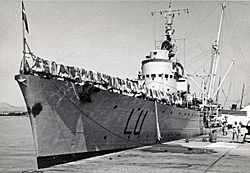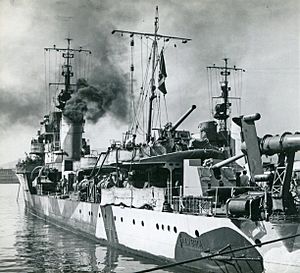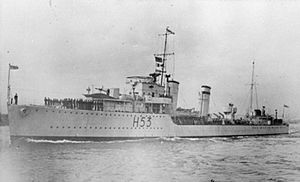Attack on Convoy AN 14 facts for kids
Quick facts for kids Attack on Convoy AN 14 |
|||||||
|---|---|---|---|---|---|---|---|
| Part of The Battle of the Mediterranean of the Second World War and the Greco-Italian War | |||||||
 Italian torpedo boat Lupo |
|||||||
|
|||||||
| Belligerents | |||||||
| Commanders and leaders | |||||||
| Francesco Mimbelli | Herbert Packer | ||||||
| Units involved | |||||||
| Lupo Libra |
|||||||
| Strength | |||||||
|
|
||||||
| Casualties and losses | |||||||
| None | 1 seaman killed 1 tanker disabled |
||||||
The Attack on Convoy AN 14 was a naval battle during World War II. It happened on January 31, 1941, near the island of Crete. A group of British and Allied merchant ships, called a convoy, was sailing from Port Said and Alexandria to Piraeus in Greece. These ships were carrying important supplies.
Two Italian torpedo boats, named Lupo and Libra, found the convoy. They launched torpedoes, which are underwater missiles. One torpedo from Lupo hit a large British tanker ship called Desmoulea. The Desmoulea was badly damaged and had to be pulled to Suda Bay in Crete. It was stuck there for the rest of the war. The other ships in the convoy mostly reached their destination safely. This battle was a small victory for the Italian navy.
Contents
What Happened Before?
Why the War Started
The Italo-Greek War began on October 28, 1940. This was when Italy attacked Greece. To help Greece, the British started sending aircraft and supplies. These supplies traveled through the Aegean Sea.
Greece helped the Allies by providing tugboats and a naval base. This base was at Suda Bay in Crete. Greece and Britain had already agreed to work together. This agreement meant Greek merchant ships could carry war supplies for the Allies.
Italian Ships Get Ready
Since the war with Britain started in June 1940, Italy had trouble supplying its soldiers. These soldiers were on islands like Rhodes in the Dodecanese. Most supplies came by submarine or aircraft. But this was not enough.
So, Italy started using smaller coastal ships. These ships carried thousands of tons of supplies. In December 1940, Italy sent a group of torpedo boats to the area. These boats were led by Captain Francesco Mimbelli. Their job was to protect the supply ships.
The Convoy AN 14
Convoy AN 14 was a group of ships traveling together for safety. It had seven British and three Greek merchant ships. These ships were protected by several warships.
The warships included the light cruiser HMS Calcutta. There were also destroyers like HMS Dainty and Jaguar. Two smaller ships called corvettes, HMS Peony and Gloxina, also helped.
Most of the convoy left Port Said on January 28. Other ships, including the large tanker Desmoulea, left Alexandria later. The cruisers HMS Ajax and HMAS Perth provided extra protection from a distance.
The Battle
On January 31, 1941, the Italian torpedo boats Lupo and Libra left their base. They were searching for enemy submarines in the Kasos Strait. Instead, they spotted the Allied convoy. The convoy was protected by a cruiser and three destroyers.
The two Italian boats split up. Libra tried to distract the escort ships. Meanwhile, Lupo attacked the convoy with its torpedoes. The Italians reported that Lupo hit a large steamer with two torpedoes. Libra also fired two torpedoes at a cruiser, but they missed. The Italian boats were shot at by the Allied escorts. But they managed to get away safely.
The British account said only one torpedo hit the tanker Desmoulea. This ship was carrying petrol and other oils. The tanker was hit around 6:00 PM on January 31. It was near the engine room and started to sink. The crew left the ship.
But then, the crew realized the ship was still floating. They got back on board. The destroyer Dainty began to tow the damaged tanker. Another cruiser, Perth, helped at first. The Desmoulea was towed to Suda Bay. It arrived at 8:00 AM on February 1. The ship was then pulled onto the beach to keep it from sinking. Its cargo was still safe. The rest of the convoy reached Piraeus a few days later.
What Happened Next?
The Fate of the Desmoulea
The Desmoulea stayed at Suda Bay for several weeks. Its back end was resting on the sandy bottom. Its cargo was moved to another tanker. Later, the Desmoulea was towed to Port Said. It arrived there on May 6. The ship was used as a temporary storage vessel.
While waiting for repairs, the Desmoulea was hit again. This time, German bombers torpedoed it on August 3, 1941. The ship was then towed all the way to Bombay in India. It ran aground twice during this long journey.
In India, the Desmoulea was turned into a stationary storage ship. It was renamed Empire Thane. The ship stayed in port until 1947. Then, it was towed back to Britain. The Desmoulea was rebuilt in 1949 and got its original name back. It was finally taken apart for scrap metal in 1961.
Casualties
Sadly, one person was killed in the attack on Convoy AN 14. He was George William Donn, the Third Engineering Officer on the Desmoulea.
See also



